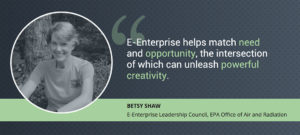
What roles do you fill on behalf of the E-Enterprise initiative?
I am a proud charter member of the E-Enterprise Leadership Council (EELC) representing EPA’s Office of Air and Radiation (OAR). The EELC sets overall direction for the E-Enterprise collaborative, and individual EELC members help lead and support E-Enterprise projects within our own organizations.
What have you found to be the most rewarding from your involvement in E-Enterprise?
“Modernizing the business of environmental protection” in a coordinated fashion across states, tribes, and EPA is a wildly ambitious goal, but through E-Enterprise, we are making good progress. From the diversity of knowledge, experience, and needs that E-Enterprise partners bring to the table, we have been able to not only tease out common principles and strategic direction, but also identify joint projects and share knowledge from individual efforts, all of which I have found very rewarding. I am particularly pleased with how use of lean tools (e.g., kaizen events, visual management) has become fairly routine for many E-Enterprise projects, and with the growing participation of tribal partners in the collaborative.
In which specific E-Enterprise projects are you currently involved, and how will these improve environmental outcomes?
EPA’s OAR has been working on several E-Enterprise-related projects since the inception of the initiative, and it is exciting to see concrete changes emerging from these efforts. For example, as recently as 2015 states submitted paper State Implementation Plans (SIPs) to EPA for review, which the agency tracked and managed using six different systems. Now, more than 400 SIPs have been submitted electronically, and by the end of 2019 we expect that several other types of submissions will be submitted under the integrated State Plan Electronic Collaboration System (SPeCs). Because OAR staff, working cooperatively with IT staff in EPA’s Office of Mission Support, developed the suite of software underlying SPeCs as a shared service (an E-Enterprise principle), the same software is being used to develop an Electronic Permitting System. A module for EPA review of state air permits will go online in 2019, with another module for EPA-issued air permits in the works.
Finally, OAR’s most ambitious E-Enterprise related project, the Combined Air Emissions Reporting (CAER) project, will deliver a Minimum Viable Product in 2020 that will allow facilities in the State of Georgia to report their air emissions for both the National Emissions Inventory and the Toxics Release Inventory using a single electronic form. Ultimately, CAER seeks to consolidate reporting to four databases: the National Emissions Inventory, the Toxics Release Inventory, the Compliance and Emissions Data Reporting Interface, and the Greenhouse Gas Reporting Program.
What lessons have you learned through your experience with E-Enterprise?
I think about what makes E-Enterprise an effective collaboration. Here are a few elements:
- The core concept of E-Enterprise is simple and compelling – states, tribes, and EPA working together to improve the business processes and supporting technologies by which we deliver environmental protection so knowledge, experience, capabilities, and resources can be leveraged across the environmental protection enterprise, and appropriate connections between partner processes and systems can be made;
- The initiative helps match need and opportunity, the intersection of which can unleash powerful creativity;
- The collaborative is well-designed with a leadership group, management group, and various teams making decisions appropriate to their respective roles and that are well-supported by excellent contractors and systems that have been developed to track progress of an expanding universe of E-Enterprise projects;
- Adaptive management is used to adjust E-Enterprise operations as needed to meet new needs and to modify projects as they encounter roadblocks;
- E-Enterprise is inclusive – of participants, ideas, and projects; and
- The sustained leadership commitment to E-Enterprise has enabled it to continue making progress as individual participants change. Those lessons will certainly inform future collaborative efforts in which I participate.
